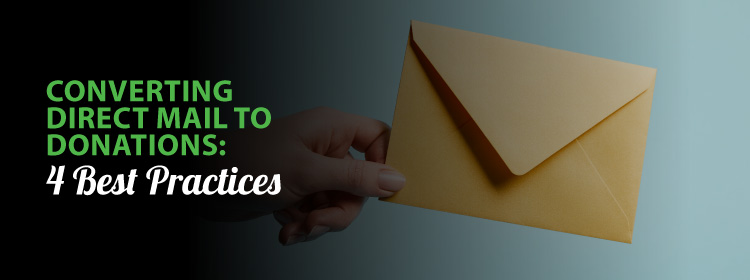Converting Direct Mail to Donations: 4 Best Practices
Direct mail is an integral part of any multichannel fundraising campaign. Your organization benefits from mail’s high visibility, response rates, and separation from online marketing clutter. There are a few best practices you can take to make the most out of your direct donation request letter efforts.
Effective direct mail can be the turning point in meeting your goals. A physical fundraising appeal can work to direct readers to your donation page, ask for volunteer time, spread news, and anything else you may need to drive your mission forward. The opportunities are vast with effective communication via physical mail.
Here at iATS Payments, we’ve worked with a wide range of nonprofits to increase their ROI in their fundraising efforts. A common challenge we’ve seen organizations run into is converting direct mail supporters to actual donors. There are a few practices you can use to make your mail work for your nonprofit:
- Strategize your direct mail fundraising appeal with donor segments.
- Add a personal touch to your mail for each supporter.
- Write effective copy in the body of your letter.
- Provide ways for donors to give through a payment processor.
With these tips in mind, you’ll get the highest ROI out of your direct donation request mail campaign. Let’s unpack some of the necessary steps.
1. Strategize your direct mail fundraising appeal with donor segments.
One of the first steps your team should take in creating a marketing strategy is to segment your audience. Categorizing your donors is easy and helps you specifically target those who can push your mission forward. Here’s how taking this simple step benefits your marketing efforts:
- Higher conversion rates
- Increased ROI
- Targeted communications
This way, you’ll be sending mail to the segments that have taken previous similar actions to help your mission. These recipients are more likely to help out versus someone who has never interacted with your cause. If you’re looking to move forward with segment your audience, here are three simple steps you can take to do so effectively:
Utilize your CRM data.
Your CRM works with the data you retain to build profiles and sort your valuable fundraising data. For example, you’re able to see the data inputted during the giving process from your donors. This can look like recent giving, events they’ve registered for, and contact info. Additionally, you’re able to track their interactions with emails you’ve sent and any other interactions with your digital marketing. If your CRM or donor database is missing key data points like date of birth, employer information, mailing address or phone numbers, a data append service can help you fill in the gaps.
Put your CRM to use by incorporating your data insights into your direct mail strategy by focusing on targeted appeals to recipients for the most effective fundraising letter possible.
Characterize your donor groups.
When you characterize your donors into groups, you will notice that each segment becomes its own subset within your organization. When this happens, it’s indicative that your data effectively targets different people who participate in your efforts. For example, a school’s groups may look like this:
- Students
- PTA Parents
- School Board Members
- Faculty and Staff
With these groups, your team can paint a picture of what it looks like to contribute to each subsection and how to communicate with them efficiently.
Plan separate outreaches to your donor subsections.
Now that your groups are separated by characteristics, your communication should be strategic for targeting their interests. For reference, DNL Omnimedia provides specific tips for segmenting your donors that your team should consider. A good way to ensure you’re leveraging this data is to make sure your fundraising letters for each group cater to their interests. Be sure to keep track of how they’re responding and adjust accordingly.
2. Add a personal touch to your mail for each supporter.
The next step after determining your donor segments is to draft your letters with personalization to each recipient. According to Experian, personalized emails deliver 6x higher transaction rates (source). You’re already making a specific ask to your subgroups, and it’s worth it for your team to go the extra mile and incorporate a bit of extra information from your CRM into each letter. Your fundraising software should even automate this process.
Here’s how to catch your donor’s eye.
- Writing Dear [their name], rather than a general salutation.
- Taking care to include the proper spelling of their name and address.
- Including details about their prior engagements.
- Recognizing donors for their previous efforts.
These personalized details can save your letter from looking like junk mail to the recipient. In taking these steps, your relationships with your donors also grow that much more. Going the extra mile confirms to your recipient that you recognize their efforts and care about them as an individual.
3. Write effective copy in the body of your letter.
Now that you have a strategy for targeting individual donors, be sure to incorporate specific writing strategies to fully establish the mission of your letter. Think about how your team can write a letter that both tells a story about your specific fundraising campaign and why you’re asking for their contributions.
Stories leverage your letter by:
- Having an emotional appeal to the reader.
- Being more memorable than numbers and facts.
- Sharing the reason why you’ve dedicated your time to this cause.
You can tell the story of why you’re devoting time and energy to this specific fundraiser in a variety of ways. For instance, communicate this through how your past efforts have positively affected the community. When recipients read of tangible results, they know your organization is capable and worth investing in.
Another storytelling route you can take is communicating why you’ve decided to form this nonprofit in the first place. If you’re stuck in writing the body of your letter, refer to this guide of fundraising letter templates for inspiration.
However you tell the story of your mission and efforts, be sure to make the donor feel like they are the hero of your story. This is effective writing because the reader will begin to picture themselves as part of the change your group is making. For example, you’ll want to directly address them as “you”. Remember, they care more about what they can do for your organization rather than general actions you’ve done on your own.
Finally, end your letter with a straightforward call to action for a donation, whether online or through physical mail. Make sure that you tell your reader exactly how you want them to take action. Don’t leave details up for interpretation as it may confuse them. These details can include:
- Asking for specific amounts. Include a variety of options for donation amounts. For example, writing out “$10, $25, $50, $100…” can help your donor picture what amount will serve your organization.
- Cater these amounts to your donor segments. With your CRM’s data, you’re able to get an idea of each recipient’s giving history. With this, you can ask for larger gifts to people with the willingness and ability to give more.
- Direct them to your giving options. The goal of your letter is to convince your reader to give to your organization. Make sure it’s clear how they can contribute with a link or QR code to a donation page, or a physical donation form.
- Provide clear contact information. If your recipient has any questions about their donation, be sure to provide multiple lines of contact. This will reinforce your relationship with them even further if they pursue this option.
With these tips in mind, you’ll be writing an effective direct mail appeal in no time.
4. Provide ways for donors to give through a payment processor.
Now that you’ve inspired your recipients to give to your cause, make sure they’re able to complete the process quickly and easily. iATS Payments explains the impact of your donation page and how its design affects the completion of the donation. If your system is confusing, it can scare away potential donors at the final step. On the other hand, providing a quick and convenient way to give encourages increased or recurring giving!
Let’s get into important items to consider when developing your donation form. Your goal is not not only to capture a single donation but to increase your efforts in any way possible. For example:
- Suggested donation amounts help donors picture what is needed for your organization to reach its goals. These can also persuade donors to give a little more than they would have previously.
- Including a recurring donation option can increase the likelihood that your supporter will consider and follow through with this giving tactic.
- Provide multiple options for giving; this can be through a physical prepaid envelope, your website, etc.
- Continued communications that donors can opt in to. Include an area where visitors can indicate that they’re interested in attending events or giving time are great for recruiting more volunteers.
- A few optional questions to boost your donor data. Consider asking simple questions such as “how did you hear about us?” to track the ROI of your direct mail campaign.
Overall, your donation page is the final and crucial step to securing donations. The choices you make can provide an easy and fast experience for donors, and ultimately can encourage future engagement and increased donations.
Your direct mail fundraising campaign can bring in a lot of donations for your organization. Be sure you’re taking the above tips into consideration to make the most of your efforts. Get the most out of your CRM and personalize your letters for increased readership, then drive them to your optimized donation page. Happy fundraising!
Author Biography
Robbie Bernstein

Robbie Bernstein, an iATS Payments Account Executive, uses her wealth of payment processing knowledge to help nonprofits thrive. Robbie puts her heart into fundraising for Cancer research, the Make a Wish Foundation and the Heart and Stroke Foundation.




